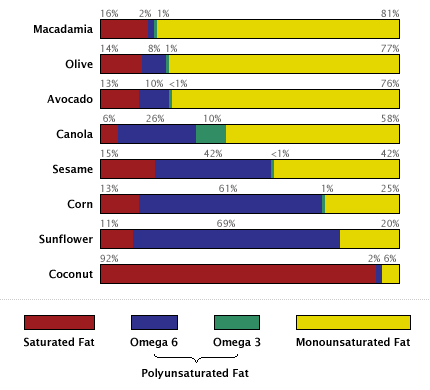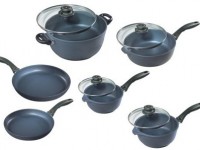My cooking revolves around the “healthy trinity” of lean proteins, friendly fats, and good carbohydrates. It may be hard to imagine how these abstractions translate into real food, but I assure you that my refrigerator is full (too full, according to my husband) of tasty incarnations.
Fats
Our bodies need fat for all sorts of processes and structures, but we can be picky about the types of fat we put into them. With respect to sources, my favorites are avocadoes, nuts, and olives, which are high in monounsaturated fats—as well as oily fish, such as salmon, with high omega-3 content. For actual cooking (as opposed to flavoring), I rely exclusively on two kinds of oil: olive and macadamia nut. The health benefits of olive oil are widely known and there is no need to repeat them here. I use it wherever its distinctive flavor is an asset. It is absolutely essential in Italian cooking and all Mediterranean cuisines, and I also use it in many Mexican, Cuban, and Caribbean dishes. I’m sure that you own at least one bottle of it, and that you know how it behaves and what it can do.
Macadamia Nut Oil, on the other hand, is a secret. Among culinary oils, it is the highest (even higher than olive oil) in beneficial monounsaturated fats and the lowest (even lower than olive oil) in omega-6 fats, which have been associated with cancer and cardiovascular disease.
Comparison of Dietary Fats and Oils

Macadamia nut oil is highest in monounsaturated fats and lowest in omega-6 fats.
Although it lacks the hydroxytyrosol of olive oil, it’s the best choice when an olive flavor would be inappropriate or intrusive. (Hydroxytyrosol is a phytochemical and powerful anti-oxidant in olive oil that appears to have aspirin-like effects.) Macadamia nut oil has an ultra-mild flavor and a high smoke point. I substitute it for canola, peanut, vegetable, safflower, sunflower, and grapeseed in recipes that call for a neutral oil. I’ve tested it in Indian, Thai, Vietnamese, Korean, Chinese, Japanese, Mexican, and Caribbean dishes with consistently excellent results. It’s perfect for stir-frying and for high-temperature roasting. Finally, macadamia nut oil offers a wonderful opportunity to “buy American” and support our own growers: Hawaii produces the best in the world!
The virtues of these two great oils are undeniable. And yet, too much of a good thing is, well, not so good. Fat—even the best kind- contains 9 calories per gram as opposed to carbohydrate and protein, which weigh in at 4. So, if you’re trying to control your caloric intake, limiting fat is a good place to start. However, because fat intensifies and conveys flavor in food, it is as indispensable in healthy cooking as in the conventional kind. I just try to be judicious about its use.
Regarding trans and saturated fats, the former have no place in a healthy diet and the latter should be minimized. Although not all saturated fats are created equal, certain ones really are worth avoiding. For example, palmitic acid (found in meat and dairy as well as some plants) increases levels of “bad” cholesterol (LDL) and then teams up with it to create conditions inside blood vessels that lead to arterial damage and cardiovascular disease. In addition, recent animal studies suggest that it may interfere with hormonal control of our sense of fullness so that we eat more than we should. Since we can’t tell the good from the bad and the ugly in animal fat, it’s best to eliminate it where we can. I use only small quantities of full fat dairy products and I’m an indefatigable trimmer of poultry and meat. If you want to know what I mean by “indefatigable”, watch the videos entitled Chicken Liposuction 1&2 and Pork Surgery.
 Multimedia
Multimedia



 Follow Me on Twitter
Follow Me on Twitter Become a Fan on Facebook
Become a Fan on Facebook